Street Fighter IV: Appeasing the Old-School
 While relaxing at a friend’s house last weekend, an ad for Street Fighter IV aired during a commercial break from SportsCenter. I recognized it right away — Chun Li and Zangief battling amidst a layer of artistic flourishes —and a lull soon filled the room as my friends followed suit. Finally, when Ken and Ryu made an appearance, one of my buddies, who hasn’t owned a game console since we met in college, spoke up.
While relaxing at a friend’s house last weekend, an ad for Street Fighter IV aired during a commercial break from SportsCenter. I recognized it right away — Chun Li and Zangief battling amidst a layer of artistic flourishes —and a lull soon filled the room as my friends followed suit. Finally, when Ken and Ryu made an appearance, one of my buddies, who hasn’t owned a game console since we met in college, spoke up.
“Is that Street Fighter?”
That, I imagine, is the response Capcom was going for. Yes, Street Fighter is back, just as you remember it, but stuffed with polygons instead of pixilated 16-bit sprites.
Actually, Street Fighter never went away. Dedicated fans kept the series alive in Japanese arcades and the few left here in the states. Each incremental release after the iconic Street Fighter II was more obscure than the last, tailor-made for players with twitch reflexes and a rock-solid memory of combos. For the average gamer, challenging any of these veterans would constitute a wasted quarter.
So in reinventing the series, Capcom had the unenviable challenge of appeasing its base while bringing lost fans — myself included — back into the fold. The result is actually quite admirable.
For average players, it’s possible to play and enjoy Street Fighter IV without knowing how the other half lives. The looks of the game are different, but the feel of its one-on-one fighting is dead-on accurate with how it used to be. Some of the same cheap combos I once used — jump kick followed by a sweeping low kick, for example — still work. Better yet, the commands for executing special moves, such as Ryu’s “Hadouken” fireball and E. Honda’s “Hundred Hand Slap,” haven’t changed at all, and they’re pretty easy to do if you have any experience.
The single player mode follows the same structure as other fighting games. You’ll start with a fairly weak opponent, then ramp up to harder foes until you’re whining in frustration as the final bosses repeatedly pummel your character. It may sound odd, but the feeling is a lot like golf; maddening during failure and euphoric upon success. I consider myself a skilled player that still doesn’t stand a chance against the truly skilled fanatics, and I barely beat the single player mode without slamming my controller into the wall.

But playing alone brushed up my rusty skills before venturing into multiplayer, where the meat of the game arguably exists. Given the level of competition over Xbox Live and my prior attempts to play fighting games online, I was expecting to lose repeatedly. Imagine my surprise when I strung together five wins in a row. It seems there is room for the novice on Xbox Live, and with a ranking system that matches players of similar skill, you’ll have at least a few months to enjoy playing online before the other casual players wander off, leaving only the dreaded veterans.
There are some nice touches to the multiplayer that keep it interesting beyond a few matches. With every win, players earn “Battle Points,” along with icons and slogans that appear next to your name when fighting. The idea of building stature through victory is addicting, and cleverly-named Xbox 360 Achievements like “The Line Starts here” conjure memories of a childhood spent in arcades. On the downside, searching for matches can be tedious, as the list of available players is often fleeting, and you’ll have to search many times to find an open slot. A “matchmaking” system similar to that of Halo and Gears of War would’ve been useful.
If you’re willing to put in the hours, there are hints to the kind of Street Fighter you can become. A “Trial Mode,” hidden deep within the game’s challenge mode, asks players to perform every move and combo for a particular character. There are even “cancel” moves that allow you to fake an opponent by stopping in attack part-way and swapping in a different one. Some of these button combinations are punishingly difficult, with hardly any window for execution. And even if you do pull them off, it’s easy to revert back to basic tactics when you’re in the heat of battle.

Despite the admirable design that went into Street Fighter IV, it’s hard to say whether I had a blast playing it. Unlike a lot of video games — and particularly, fighting games like Soul Calibur that subsist on button-mashing — Street Fighter IV doesn’t provide instant gratification. Like an actual martial art, it gives back only what you put in.
That’s why the series has survived through the years. The most dedicated players compete so intensely among themselves that it never gets old to them. I imagine some new players will discover this level of play and become intoxicated by it, but the rest of us will enjoy Street Fighter IV as a nostalgia act for a type of fighting game that’s mostly faded from relevance. In a while, Capcom’s prized fighting franchise will become obscure once more.
Comments are closed
Read more:













By Jared Newman | Friday, February 27, 2009 at 3:07 pm